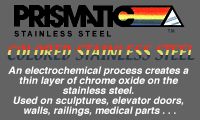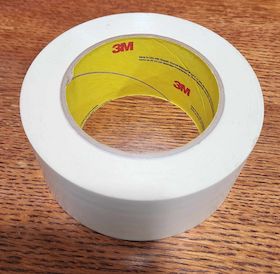
-----
"Rainbowing" and "Bluing" method for Stainless Steel
Quickstart: There are many ways to color stainless steel addressed in this discussion, from black oxiding, through anodizing, heat tinting, and blue ion physical vapor deposited coatings.
Q. I know this is an old thread but any luck doing green on stainless steel?
Josh BrackenreedMetal artist - Leduc alberta
February 7, 2022
A. Various colors on stainless steel 18 Cr / 8 Ni)
7,5 grams of sodium dichromate, 1000 ml of sulfuric acid (1,24 g/cm3), lead cathodes, object as an anode, 70-90 °C temp., 0,06 A/dm2, voltage 1,3 V - colors depend on the duration of the procedure (5-50 min.), brown, blue, reddish brown, yellow, green.
According to Russian literature after processing items should be soaked in a solution of potassium bichromate (5-10%), 5-15 minutes, 70-90 °C temperature of the solution. According to one Chinese patent treated objects can be then immersed in a hot diluted sodium silicate solution (1-5%, 95 °C, 3-10 min. ). Hexavalent chromates are carcinogenic and toxic, molybdate-based solutions are now being proposed as a substitute.
According to Wikipedia article on Chemical coloring of metals. Hope it helps and good luck
- Cerovski vrh Croatia
Ed. note Jan. 2024: As Goran notes, processes involving hexavalent chrome (dichromate, bichromate) are no longer considered acceptable in much of the world.
A. Immersion in boiling solution of 950-995 ml water and 5-50 ml phosphoric acid
⇦ on
eBay
or
Amazon [affil link] can be used too (according to USPT 2,521,580). 180 minutes! Hope it helps and good luck!
- Cerovski vrh Croatia
Q. Hello Goran, as a hobbyist trying to color SS watch components, the phosphoric acid
⇦ on
eBay
or
Amazon [affil link] method looks suitable for me. I have read the original patent document where they have mentioned that temperatures lower than boiling point of the solution would work as well. Does this mean that the process can be performed at room temperature?
Also after the process is complete, is further passivation required as per Japanese/Russian patent suggestions?
- India
December 18, 2023
A. You must test that process, if 100 °C = 180 minute, maybe at 50 °C = 360 minutes and at 25 °C = 720 minutes...
I think that you can try ex USSR patent SU 815081 too: 100 g sodium thiosulphate
⇦ on
eBay
or
Amazon [affil link]
, 10 g lead acetate, 12 g potassium sodium tartrate
⇦ on
eBay
or
Amazon [affil link]
, 12 g copper sulfate
⇦ on
eBay or
Amazon [affil link] , 1 lit water, 18-22 °C temperature of solution, 5-50 minutes, yellow, brown, red, green, blue, violet. Object must be in contact with piece of copper 300 times smaller surface than surface of treated object. Hope it helps and good luck!
- Cerovski vrh Croatia
January 5, 2024
A. Lead acetate is a toxic compound and probably can be replaced with copper acetate according to patent US20030159762A1. Hope it helps and good luck!
Goran Budija- Cerovski vrh Croatia
January 7, 2024
A. According to Chinese patent CN101173367B you can use 30 to 100g molybdate, 10 to 18g boric acid, and 0.5 to 5g manganese sulfate. There are at least 2 other Chinese patents with somewhat different molybdate based solutions...Hope it helps and good luck!
Excellent article on anodizing stainless steel ⇨
- Cerovski vrh Croatia
December 13, 2024
⇩ Related postings, oldest first ⇩
Q. I would like to get full details on the electrochemical process of coloring stainless steel. If anyone can give me details or suggest the source to obtain this information, I would be very much obliged.
PRADEEP GOPALAN- CHENNAI,TAMIL NADU, India
2000
A. Hi Pradeep.
In addition to this page, please see:
thread 1383, and thread 16927, and thread 24520
for lots of info about anodizing/coloring of stainless steel. Good luck!
Regards,

Ted Mooney, P.E. RET
Striving to live Aloha
finishing.com - Pine Beach, New Jersey
Ted is available for instant help
or longer-term assistance.
A. Hi Mr. Gopalan. I am a graduate student of Shiraz University. Me & my friend work on coloring of stainless steel. Before us, another graduate student of Shiraz University worked on this. She could give green, blue, black, brown and ... color on stainless steel. I can give you any information we have, if you give us any information you have about this.
WITH THE BEST REGARDS,
Shiraz university - Shiraz-Fars-Iran
Ed. note -- Ali, Pradeep:
This forum is for public sharing of whatever people are willing to share; unfortunately, private hook-ups disenfranchise the other readers who were following the discussion with curiosity, and then were disinvited; so this forum doesn't assist with that. Apologies :-)
Multiple threads merged: please forgive chronology errors and repetition 🙂
⇦ Tip: Readers want to learn from your situation;
so some readers skip abstract questions.
Q. I am interested about stainless steel coloring, I would like someone to help me how to get the information about this, including the process and chemicals needed.Thank you
Musdinoviria- Banyuwangi, East Java, Indonesia
2001
A. Hi Musdinoviria,
Responders can continue to describe the process & chemicals for electrolytic coloring (anodizing) for you, but other readers should not infer from this that electrolytic coloring is the only coloring option for stainless steel :-)
Stainless steel can also be black oxided (contact Birchwood Technologies [a finishing.com supporting advertiser] or EPI / Electrochemical Products Inc. [a finishing.com supporting advertiser]), PVD coated in various materials & colors, coated with titanium rainbow interference coatings, heated & oil quenched, or colored with dyes (try colored permanent markers
⇦ on
eBay
or
Amazon [affil link] .
It may often be best to start such questions with what kind of items you want to colorize and why, what level of durability is required, and what environment they will be seeing.
Luck & Regards,

Ted Mooney, P.E. RET
Striving to live Aloha
finishing.com - Pine Beach, New Jersey
Ted is available for instant help
or longer-term assistance.
A. Electrolytic colour for SS (Ni/Cr 18/8):
H2SO4........ 1 lit
Na2Cr2O7...... 7,5 gm
70-95 °C,
0,06 A/dm2,
1,3V,
object = anode, cathode = lead
Colour sequence:brown-blue-yellow-reddish brown-purple-green.
Budija, Goran- Zagreb, Croatia
2003
Q. This is very helpful but what strength sulfuric acid? More details if you could please. Thanks.
Frank Gyuru- Clearwater, Florida, USA
2004
A. You must use 1,24 g/cm3 (density) sulfuric acid! Today I think that alkaline process is a better solution, and it is RoHS-compliant:
NaOH.....700 gm
KMnO4....10 gm
Na2S.....1 gm
H2O......1 lit
temperature 110-120 °C
20 V
Colour sequence: brown (3 minutes) - purple (40 minutes) - black (60 minutes)
According to Dettner/Elze: Handbuch der Galvanotechnik [occasionally avail. from
eBay,
AbeBooks, or
Amazon affil links]
- Zagreb,Croatia
Q. Goran, in the coloring of stainless steel that you described I would like to know what type of cathode you are using.
I am experiencing some problems using a lead cathode; it seems to be degrading during the anodizing process.
- Cleveland Ohio
October 6, 2014
Ed. note: Are you sure the lead is cathodic (attached to the negative)?
"Blue Ion" Plating
Q. I am in the medical industry and am looking for a surface finish for 316L SS resulting in a light purple or blue color. Finish must be able to stand up to high heat and moisture when being sterilized in an autoclave. Because of high use, it should not scratch easily. I have heard the term "blue ion plating" on SS, but have not had any success finding additional information. Thanks in advance for the help.
John Koontz- Irvine, California, USA
2001
A. I haven't heard of "blue ion plating" either, but it probably means a PVD-applied (physical vapor deposition) hard coating on the stainless steel of a blue color. I think if you look for job shops that offer PVD coatings they will be familiar with what you need. Or, if your needs are big enough to afford a multi-million dollar machine to do the processing in-house, the manufacturers of PVD machines will be familiar with this.
As a note to other readers interested in coloration of stainless steel, PVD processes are only applicable to high volume items because the owner/operators of these multi-million dollar high vacuum machines are concerned with potential costly contamination from a onesy-twosy order, and they also can't afford to cycle a machine nearly empty that was designed for handling hundreds or thousands of parts per cycle.
Regards, and good luck.

Ted Mooney, P.E.
Striving to live Aloha
finishing.com - Pine Beach, New Jersey
Ted is available for instant help
or longer-term assistance.
Ed. update Dec. 2023: "Blue Ion" plating has become quite popular for stainless steel in the intervening years.
adv. (affil link): 'Blue Ion' jewelry & watches on eBay and on Amazon [affil link]
Q. My hobby is modifying and customizing pocket knives for my personal use. The blades are typically stainless steel of various types. I would like to know how to "color" stainless steel as one would "blue" gun metal. Another interesting effect I've seen is giving the SS rainbow hues. It would be great to find out how I can do that. Will these same processes work on titanium and aluminum?
Thanks for your help,
Ed Acunzo- New Orleans, Louisiana
2003
Q. Hi, I am on the lookout for bluing stainless steel. We manufacture mugs, and are looking for the variety that could be provided by color on the metal. Since it's a product of everyday use, I am looking for something that would be permanent and resistant to washing and scrubbing and, very importantly, non-toxic. Thanks for the help.
Rishi Jain- Bombay, India
2004
A. Hello Ed,
Black oxiding (bluing) of stainless steel is done industrially in a fashion very similar to black oxiding of steel, but with modified proprietary chemistry such as offered by Birchwood Technologies [a finishing.com supporting advertiser] or EPI / Electrochemical Products Inc. [a finishing.com supporting advertiser]. If you know how to do black oxiding you could experiment on the stainless. Note that hot black oxiding can be very dangerous because it often involves strong caustic solutions at 270+ °F. When water is added to make good the evaporation losses from the boiling hoy solution, there is great potential for the solution to virtually explode because water flashes to steam above 212 °C.
Rainbow coloring of stainless steel can be done by a proprietary process called Prismatic Stainless Steel [from B&M Finishers, a finishing.com supporting advertiser] and perhaps other processes
However, titanium is better for brilliant clear colors, and the pocket knives you saw probably had titanium applied to the stainless steel in a PVD vacuum chamber. A hobbyist will be able to experiment with some stainless steel coloring processes but will not be able to afford and install a vacuum chamber for the PVD application of titanium.
Although titanium and aluminum can also be anodized, the processes are very different. The coloring in titanium and stainless steel anodizing is due to the formation of thin refractive films (like the rainbow from oil on a puddle), but colors are applied to aluminum by anodizing and then filling the millions of microscopic drill holes in the anodized film with dyes.
A. Hello Jain,
Black oxide / bluing is just a coating of black rust millionths of an inch thick and would be inappropriate for an application requiring washing and scrubbing. The above-mentioned Prismatic anodizing might be appropriate though, as well as various other coloring and PVD processes. Good luck.

Ted Mooney, P.E.
Striving to live Aloha
finishing.com - Pine Beach, New Jersey
Ted is available for instant help
or longer-term assistance.
Multiple threads merged: please forgive chronology errors and repetition 🙂
How to Anodize Stainless Steel Green
Q. I have stainless steel parts for my car, and I would like to know what I need to do to anodize them green.
T. Schraderstudent - Camanche, Iowa
2004
? Are you sure they're stainless? While it is fairly common for hobbyists to anodize aluminum, I don't know of hobbyists anodizing stainless steel. I do know of proprietary processes for anodizing stainless steel though, but I believe that green is a difficult color to get from interference coloring.

Ted Mooney, P.E.
Striving to live Aloha
finishing.com - Pine Beach, New Jersey
Ted is available for instant help
or longer-term assistance.
A. Yes you can
SS colour anodizing (only for 18/8 SS):
1 lit sulfuric acid
7,5 gm sodium bichromate
object=anode, cathode= lead
70-95 °C temp.,0,06 A/dm2, 1,3 V
Colour sequence brown - blue - yellow - reddish brown - purple - green.
----- I take no credit for this info I got it off another post on this site -------
- Bessemer, Alabama
2006
! Thanks, Craig; this in turn came from Dettner & Elze: "Handbuch der Galvanotechnik" [occasionally avail. from eBay, AbeBooks, or Amazon affil links]. But hobbyists should note that sodium bichromate (sodium dichromate) is concentrated hexavalent chromium -- the toxic and carcinogenic material that made Erin Brockovich [adv: DVD on eBay & Amazon affil links] a household name; we don't know what cautions if any are included in that handbook.
Goran is exceptionally knowledgable and always very helpful; but note that he is an accomplished professional metals conservator, and trying to do your own home-brew like he is able to do may not be for everyone. For those who may be looking for a commercially available process for coloring stainless steel, from a shop with long experience in it, you can try finishing.com's supporting advertiser B&M Finishers / Prismatic Stainless Steel [a finishing.com supporting advertiser] [Kenilworth, NJ]; they call the process "Prismatic Finishing". Good luck.
Regards,

Ted Mooney, P.E.
Striving to live Aloha
finishing.com - Pine Beach, New Jersey
Ted is available for instant help
or longer-term assistance.
Q. Craig, can you tell me how much % sulfuric acid to have? Is it 98%? BTW, sorry for my English.
Luck Ancypo- Sokolka Poland
August 10, 2011
A. Hi, Luck.
We've now combined several threads including one where Goran Budija notes that the H2SO4 is 1.24 gr/cm3, i.e., about 28% (about the strength of battery acid ⇦ on eBay or Amazon [affil link] ).
Regards,

Ted Mooney, P.E.
Striving to live Aloha
finishing.com - Pine Beach, New Jersey
Ted is available for instant help
or longer-term assistance.
August 10, 2011
Q. Aircraft seat buckles. Hi is it possible to anodize 2 different metals at the same time, i.e., aluminium and chromed steel
Rog Comberhobby - England
February 9, 2008
A. Hi, Rog. Sorry, anodizing of aluminum and your other processes must be done before assembly unless you are capable of meticulous and robust masking.

Ted Mooney, P.E.
Striving to live Aloha
finishing.com - Pine Beach, New Jersey
Ted is available for instant help
or longer-term assistance.
Q. We are looking for recommendations on the most robust method of treating/coating a stainless steel sculpture to withstand outdoor exposure. Hopefully we could get multiple colors, not just black. However black is also needed.
Thanks!
builder - Loveland, Colorado, USA
May 15, 2009
Q. Anyone know how to do peacock blue on SS parts?
Younas Bajwadental parts mfg - Chicago, Illinois, USA
March 29, 2011
A. Hi Younas.
This is most likely done via PVD processing as previously described on this page. Search for "blue ion plating"
Luck & Regards,

Ted Mooney, P.E. RET
Striving to live Aloha
finishing.com - Pine Beach, New Jersey
Ted is available for instant help
or longer-term assistance.
Q. What process will Color Stainless Steel Screws Gold in color?
Jerry SiegelManufacturer - Los Angeles, California
March 23, 2011
A. It's pretty common to coat stainless steel screws with titanium nitride to get the gold color. Cathodic arc deposition works best. You get the best adhesion with the arc and superior part coverage. The coating is thin enough that it will not affect the screws' performance, and in most cases it will improve it.

Jim Treglio - scwineryreview.com
PVD Consultant & Wine Lover
San Diego, California
A. Jerry,
We have not paid much attention to this technology for a long time, since the most obvious way to color stainless steel is to use hazardous chemicals. However due to massive requests to find the bio-acceptable electrolytes and eco-friendly process to color-code medical stainless steel surgical instruments, we have decided to dedicate some time to research and experiments. See attached pics - our results.
adv.
Contact us for more information.
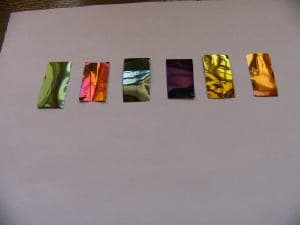
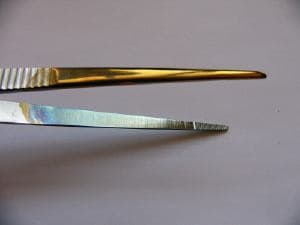
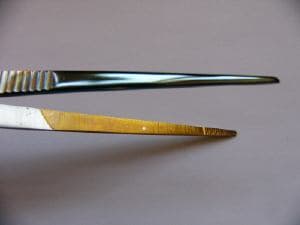
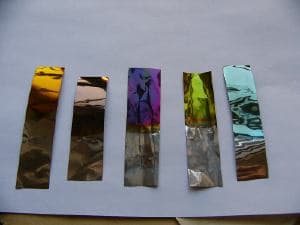
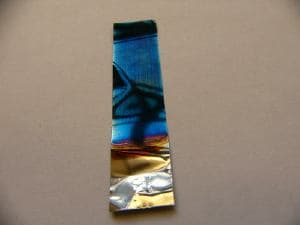

Anna Berkovich
Russamer Lab - Pittsburgh, Pennsylvania
(ed. update July, 2025: sorry, Anna has retired)
A. Probably the simplest way is just to use heat. It takes a bit of practice, but small objects can be heat colored with a simple propane torch. Larger objects can be run through an oven. It is most important to ensure that the surface is clean.
I hope this helps.
- Philadelphia, Pennsylvania, USA

! I am cutting a logo out of stainless steel. The logo has several colors in the original. This is made of fabric; but I am reproducing it in stainless steel (red, blue, gold, white).
John liptrot- napa, California U.S.A.
September 16, 2014
![]() Hi John. Please send us a photo of the stainless steel logo when you finish it. Paint is the most obvious solution. Any idea how you are going to achieve white and gold, other than with paint? (I don't see gold in the fabric logo).
Hi John. Please send us a photo of the stainless steel logo when you finish it. Paint is the most obvious solution. Any idea how you are going to achieve white and gold, other than with paint? (I don't see gold in the fabric logo).
Regards,

Ted Mooney, P.E.
Striving to live Aloha
finishing.com - Pine Beach, New Jersey
Ted is available for instant help
or longer-term assistance.
Rainbow Stainless Steel
Q. Please help me and explain How to Colour Stainless Steel using Chemical Process?
Thank You.
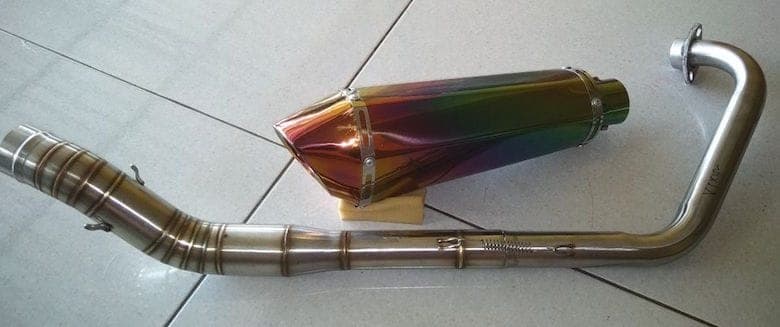
Best Regards,
Andhi SantosaHobbyist - Indonesia
June 27, 2018
A. Hi Andhi. This thread, along with 1383, 16927, and 24520 cover it pretty exhaustively. Good luck!
Regards,

Ted Mooney, P.E. RET
Striving to live Aloha
finishing.com - Pine Beach, New Jersey
Ted is available for instant help
or longer-term assistance.
Q. I would like to create a celtic symbol of three ravens swirling together on a brushed stainless plate. I want the brushed stainless to be the background and using a template only etch and color the raven bird pattern. I'd like to create colors of black, blue, purple and brown... but no pattern to the colors... just a swirled look like when you see a raven in the sun from different angles and can see the colors.
Any ideas on how to do this? The plate is brushed 304 grade stainless steel 15 x 15 inches square.
Thanks for any help or suggestions!
Blue Earth, LLC - Manhattan, Kansas, USA
February 1, 2019
A. Hi Jeff. I think you might find splash anodizing of aluminum or rainbow anodizing of titanium easier than anodizing stainless steel. But with any of the materials the first step is to mask what you don't want colored. If you don't want to get involved in photomasking and special materials, you can probably cover the whole surface with platers' tape ⇨
(possibly even electricians tape), and cut out your celtic symbol with an Exacto knife
⇦ on
eBay
or
Amazon [affil link] , then experiment with formulas and procedures as described by Goran and others.
Gradually taking the tape off the patterned area so you get different immersion times and depths should offer some color variation. But it's best to spend time experimenting with scrap before doing the actual piece.
Regards,

Ted Mooney, P.E. RET
Striving to live Aloha
finishing.com - Pine Beach, New Jersey
Ted is available for instant help
or longer-term assistance.
A. Hello!
Regarding colorizing a pattern on stainless steel, I'm wondering whether "Firescoff"
⇦ on
eBay
or
Amazon [affil link] , or something similar, might work if the areas not to be colorized were coated, and the areas to be colored heated with a small torch?
Since such coatings are used to protect areas of a work (including even gemstones, I think) from heat damage, it seems reasonable. I don't know whether any are sprays that could be used with a stencil, or whether they'd need to be painted on (especially if thick layers are needed). But it might be worth a look?
I hope that helps!
- Houston, Texas, USA
March 21, 2019
304SS - Should knitting needles be heat-treated?
Q. Hello!
Since they are not commercially available, I'm going to make some long (20") straight knitting needles for knitting lace (I know there are "circular" ones with cables attached, but the needles themselves are far too short for me to manipulate). I ordered 3mm-diameter 304SS rod and will sharpen the tips as needed, then polish, using down to 12,000 grit or if possible, finer.
OK, so, my question is, Since these will be in my hands *a lot*, and since they also will be used with white or light-natural cotton crochet thread, would torching them result in a surface more resistant to oxidation?
I ask because I had bought some cheapo stainless steel needles, and they get a gray layer on them which spoils the yarn.
Since The only chemicals I keep around the house are NaOH
⇦ on
eBay
or
Amazon [affil link] , and citric acid
⇦ on
eBay
or
Amazon [affil link] (both as dry granules). I assume chemical treatment is not doable. I do have low-voltage widgets for basic (meaning "primitive") electrical etching, but again, I don't have the items I've seen recommended for plating or anodizing or any of that.
So that's why I'm focusing on heat...
Thanks in advance for any info/advice!
"one of my too-numerous hobbies" - Houston, Texas USA
March 21, 2019
A. Hi Kris. The phrase "heat-treat" is usually reserved for heating processes which make a material harder, so you might run into some confusion because people will tell you that type 304SS cannot be heat treated. I would think that passivating the stainless steel with citric acid is the best approach and is something that you can do with materials on hand.
I've never worked with lace but I'd suspect that oils from extensive handling with your hands would discolor them and wonder if the thing to do might not be to wear thin latex gloves ⇦ on eBay or Amazon [affil link] rather than trying to make the stainless steel impervious to hand oils?
Regards,

Ted Mooney, P.E. RET
Striving to live Aloha
finishing.com - Pine Beach, New Jersey
Ted is available for instant help
or longer-term assistance.
![]() Hello and thank you for your reply!
Hello and thank you for your reply!
To first address your suggestion of wearing thin gloves, I can't manage that - the work is small in scale and I don't have enough dexterity to do it in gloves. I received my rods this morning and I think, with treatment, they'll withstand the handling and skin oils. I strongly suspect that the cut-rate "stainless steel" knitting needles I had bought were also cut-rate steel.
Moving right along:
Apologies for my inaccurate terminology - I admittedly pick info up willy-nilly, and the same goes for me confusing "heat treatment" with "heat tinting", which I actually had discovered while looking into how to "weave" chain-maille-type chains.
ANYWAY, since you gave me the correct terminology, I was able to do some searches on "citric acid passivation", and the "Nutshell Version" seems to be:
1) clean to remove grease,
then
2) "soak" for 30 minutes in a 150 °F bath of 10%-by-weight solution of citric acid in Distilled Water.
If I've understood it correctly, it's fairly straightforward and definitely worth a try, once I've finished grinding the points and polishing/smoothing the units.
Thanks again!
- Houston, Texas, USA
Ed. note: Necessity is the mother of invention: Nurses do injections and blood draws wearing gloves; Dentists even do root canals wearing them :-)
Q, A, or Comment on THIS thread -or- Start a NEW Thread
